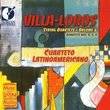| All Artists: Endre Szervanszky, Gyorgy Ligeti, Gyorgy Kurtag, Gyorgy Orban, Berlin Philharmonic Wind Quintet Title: Berlin Philharmonic Wind Quintet: Ligeti, Kurtág... Members Wishing: 1 Total Copies: 0 Label: Bis Release Date: 10/14/1994 Album Type: Import Genre: Classical Styles: Chamber Music, Historical Periods, Classical (c.1770-1830) Number of Discs: 1 SwapaCD Credits: 1 UPC: 789368013920 |
Search - Endre Szervanszky, Gyorgy Ligeti, Gyorgy Kurtag :: Berlin Philharmonic Wind Quintet: Ligeti, Kurtág...
 | Endre Szervanszky, Gyorgy Ligeti, Gyorgy Kurtag Berlin Philharmonic Wind Quintet: Ligeti, Kurtág... Genre: Classical
|
Larger Image |
CD DetailsSimilar CDs |
CD ReviewsOught to be of interest for Kurtag fans, and the Ligeti's qu Christopher Culver | 12/04/2009 (4 out of 5 stars) "This BIS disc from 1994 brings together wind quintets by four Hungarian composers performed by the Berlin Philharmonic Wind Quintet. As I heard this disc while exploring the output of Kurtag and Ligeti, I'll limit my comments to their pieces, though Szervánszky and Orban compositions are also present on the disc.
For me the big attraction of this disc was Gyorgy Kurtag's Wind Quintet (1959), his opus number two, recordings of which are not easy to track down. Already well into his 30s, Kurtag famously suppressed his socialist realist output of the 1950s and moved instead towards an extremely compressed synthesis of Bartok and Webern, which he revealed to the world with his String Quartet op. 1 (best heard by the Arditti's on a Naive disc). Written in the same year, the Wind Quintet inhabits a similar soundworld. Its eight movements last only between 38 seconds and 1 minute 48 seconds, but each seems to encapsulate a satisfying musical statement. The language is angular in its leaps among odd intervals, but there's a lively variety of rhythms. Kurtag followed this uncompromising aesthetic through other works like "Jelek" for viola and "Splinters" for cimbalom, and if you like all those other early efforts than you'll enjoy the Wind Quintet. Gyorgy Ligeti wrote two wind quintets, both of which appear here. The first, the Six Bagatelles for Wind Quintet (1953) is an early piece where Ligeti's ideas of the future of music drew mainly from Bartok. The music is unadventurous compared to his mature period, but the astringent chromaticism of the pieces must have sounded radical in Stalinist-era Hungary, and Ligeti showed here a mastery of a smooth, early 20th century style before he moved on to something revolutionary indeed. The first of these bagatelles is an arrangement of the third movement of his "Musica Ricercata" for solo piano, and it is fun to hear this convival music with an wider array of timbres. Ligeti's Ten Pieces for Wind Quintet (1968), on the other hand, is from well into his era of "micropolyphony". At times the music is built up from voices layered so intricately that the ear perceives only a perpetually shifting whole, but the presence of only five instruments sometimes leads to more expressive moments. The piece sometimes plays with difference tones, and though a recording can't always produce the same effects as hearing the piece live, in the ninth movement at least you'll get an idea of what Ligeti was after. The Berlin Phil's wind quintet gives these a fine performance, but as always with Ligeti I tend to favour the Sony recording (by the London Winds) which has the composer's imprimatur." |

 Track Listings (31) - Disc #1
Track Listings (31) - Disc #1
